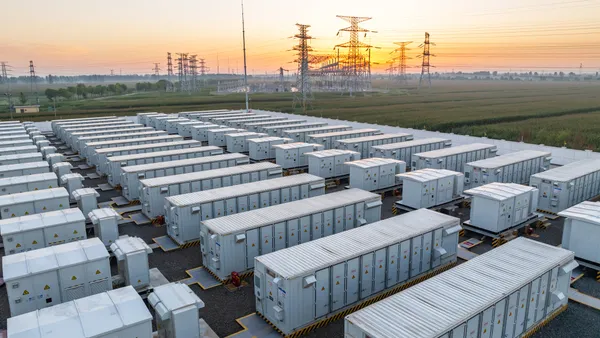Dive Brief:
- Connecticut Gov. Ned Lamont, D, is set to sign a bill that would establish a goal of deploying 1,000 MW of energy storage by the end of 2030, making it the eighth state to set an energy storage target.
- SB 952, which passed the state House unanimously last week, also sets interim targets of deploying 300 MW of storage by the end of 2024 and 650 MW by the end of 2027. The bill had previously passed the state Senate in a unanimous vote.
- The state’s Public Utilities Regulatory Authority (PURA) began a proceeding this year to create consumer incentives to encourage storage development, which PURA director of utility programs and initiatives Josh Ryor said will be essential to meeting the legislation’s goals. "It’s a balancing act," Ryor said, "to ensure consumer adoption and making sure the value of storage is clear to the consumer."
Dive Insight:
At the beginning of 2021, the state Department of Energy and Environmental Protection (DEEP) laid out a draft plan to get Connecticut to 100% zero-carbon energy by 2040, in line with a goal set by Lamont in 2019. The DEEP plan said that meeting the goal would require reforms to ISO New England’s wholesale electricity market, as well as demand response and storage incentives at the state level to address the intermittency of wind and solar production.
The storage target is a "clear signal to the industry that the state is committed to storage and its role in getting us to a clean energy future," said Sean Burke, a policy associate for the Northeast Clean Energy Council.
"This goal is among the most ambitious in the Northeast and is coupled with a requirement to take concrete action to meet that goal and deliver ratepayer benefits," Burke told Utility Dive.
Under the bill, PURA is required to start a proceeding to develop strategies and funding to interconnect energy storage with the distribution grid and develop rate design incentives to encourage storage development. Earlier this year, PURA proposed an incentive program with a goal of deploying 580 MW of storage by 2030, a process informed by the introduction of a storage target bill in last year’s legislative session. To help meet the remainder of the 1 GW legislative storage target, the bill gives DEEP the authority to pursue procurement of energy storage.
The PURA proposal included up-front incentives to defray the cost for homeowners and businesses to purchase a storage system that could dispatch energy during summer peak hours, as well as annual performance incentives for customers who allowed utilities to dispatch their stored energy during demand response events. PURA’s Ryor said those incentives are key to increasing consumer adoption, especially after a Connecticut Green Bank analysis found that a cost-benefit value for storage purchasers in the state was essentially even and that the "availability of appropriate upfront incentives will be crucial." There also haven’t been consumer benefits for storage through the state’s net metering program, Ryor added.
"What makes me optimistic is that there’s been a lot of interest and uptake without a lot of real incentives. We’re starting from a good place," Ryor said. "Now we’re going to create a program that maximizes the benefits to the grid and to its participants."
Connecticut now joins seven other states — New York, New Jersey, California, Nevada, Massachusetts, Oregon and Virginia — in setting an energy storage target in combination with a clean energy deployment goal. Those state-level policies, when paired with incentives, can help accelerate the transition to renewables by addressing reliability concerns and setting a guide for other governments on how best to encourage storage, said Burke.
"This bill sets Connecticut as a regional leader in understanding how we can reach our climate goals using a breadth of technologies and policies," Burke said. "It recognizes the flexibility of energy storage and its ability to meet a variety of goals."
Correction: An earlier version of this story misnamed Sean Burke's employer. He works for the Northeast Clean Energy Council.














